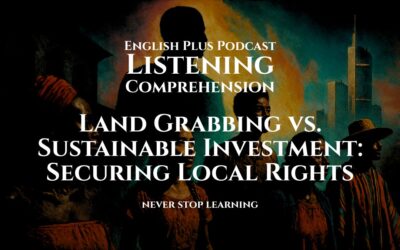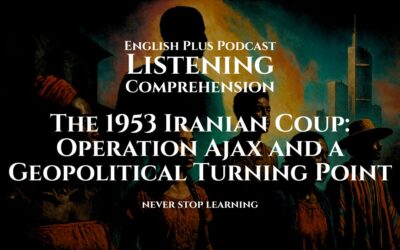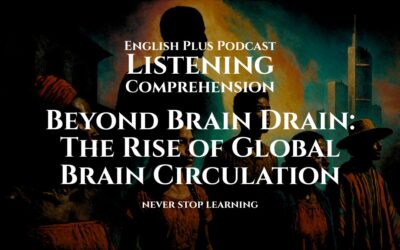Sharpen Your Listening Skills for Exam Day 🧠
Welcome to your listening comprehension practice! On exams like the TOEFL and IELTS, you’ll often listen to academic lectures. The key to success isn’t just understanding the words, but understanding the structure of the argument.
As you listen to today’s lecture on critical thinking, try these tips:
- Predict the Content: The topic is “The Importance of Critical Thinking in Education.” What do you expect the speaker to talk about? Probably a definition, some history, its benefits, and how to apply it. Thinking about this beforehand primes your brain.
- Listen for the Main Idea: Don’t get lost in the details. In the first minute, try to identify the speaker’s main point or thesis. Every other detail should support this main idea.
- Note the Structure: The speaker will use “signposting language” like “First,” “Another key aspect is,” or “In conclusion.” Use these clues to organize your notes and follow the flow of the lecture.
- Distinguish Fact from Opinion: The lecturer will present facts but also their own perspective. Pay attention to phrases like “I believe,” “It seems crucial that,” or “The evidence suggests,” which can signal the speaker’s stance.
Ready to put your skills to the test? Let’s begin.
Key Vocabulary and Phrases
Here are some keywords and phrases from the lecture. Understanding them will help you master the content.
- Pedagogy (noun): This is a fancy word for the method and practice of teaching. It’s about the theory of how we teach, not just what we teach.
- In the lecture: “This shift requires a fundamental change in our pedagogy, moving away from the teacher as a source of all knowledge…”
- Rote Memorization (phrase): This is the process of learning something by repeating it over and over again, without necessarily understanding its meaning. Think of memorizing multiplication tables.
- In the lecture: “…an education system that often prioritizes rote memorization over genuine understanding.”
- Socratic Method (noun): A teaching technique named after the philosopher Socrates. It involves asking a series of probing questions to stimulate critical thinking and expose the underlying assumptions in someone’s ideas.
- In the lecture: “Its roots can be traced back to the Socratic method of ancient Greece, where questioning was valued more than answering.”
- Cognitive Dissonance (noun): This is the mental discomfort you feel when you hold two or more contradictory beliefs, or when your beliefs clash with your actions. It’s that uneasy feeling that pushes you to change one of them to find consistency.
- In the lecture: “It’s about developing a tolerance for ambiguity and even for the discomfort of cognitive dissonance…”
- Holistic (adjective): This means looking at something as a whole, interconnected system rather than just a collection of separate parts.
- In the lecture: “A holistic approach to education, therefore, must have critical thinking at its very core.”
- Inculcate (verb): To instill or teach an idea, attitude, or habit through persistent instruction. It means to fix something firmly in someone’s mind.
- In the lecture: “Our goal is not merely to teach students what to think, but to inculcate in them the how of thinking.”
- Discourse (noun): This refers to written or spoken communication or debate. When we talk about academic discourse, we mean the formal way ideas are discussed and debated in a particular subject.
- In the lecture: “…to engage in reasoned discourse, to build a coherent argument, and to deconstruct the arguments of others.”
- Metacognition (noun): Simply put, this is “thinking about your own thinking.” It’s the ability to step back and reflect on your own learning process, to understand your strengths and weaknesses as a thinker.
- In the lecture: “This process is often referred to as metacognition, or ‘thinking about thinking’.”
- Scrutinize (verb): To examine something thoroughly and carefully, paying close attention to every detail.
- In the lecture: “It is the ability to scrutinize information, to question its source, to identify underlying biases…”
- Paradigm Shift (phrase): This means a fundamental change in the basic concepts and experimental practices of a scientific or academic discipline. It’s a major change in how people think about something.
- In the lecture: “Fostering this skill requires nothing less than a paradigm shift in our approach to education.”
Listening Audio
Listening Transcript: Please do not read the transcript before you listen and answer the questions.
Listening Script: The Importance of Critical Thinking in Education
Good morning, everyone. Today, I want to talk about a skill that is, in my view, the single most important outcome of a genuine education, yet it is often the most neglected. I’m referring to critical thinking. We live in an age of unprecedented information access. With a few clicks, we can summon a near-infinite library of facts, opinions, and data. But this deluge of information presents a profound challenge. How do we navigate it? How do we separate the credible from the questionable, the signal from the noise? The answer lies in critical thinking.
What exactly is critical thinking? It’s a term that’s thrown around a lot, but its definition can be elusive. At its core, critical thinking is the intellectually disciplined process of actively and skillfully conceptualizing, applying, analyzing, synthesizing, and evaluating information. That’s a mouthful, I know. Let’s break it down. It’s not about accumulating information. The internet has already won that game. It is the ability to scrutinize information, to question its source, to identify underlying biases, and to recognize the difference between a reasoned argument and a piece of emotional manipulation. It’s about becoming the master of your own mind, rather than a passive recipient of external data.
The modern educational landscape often stands in stark contrast to this ideal. For centuries, the dominant model has been one of information transmission. The teacher, the expert, stands at the front of the room and dispenses knowledge, which students are expected to absorb and later regurgitate on an exam. This model, rooted in the industrial age, was designed to create a compliant workforce. It values conformity and correct answers over intellectual curiosity and reasoned inquiry. It is an education system that often prioritizes rote memorization over genuine understanding. But in the 21st century, where facts are cheap and easily accessible, this model is obsolete. The world no longer rewards people for what they know, but for what they can do with what they know.
Fostering this skill requires nothing less than a paradigm shift in our approach to education. Our goal is not merely to teach students what to think, but to inculcate in them the how of thinking. This shift requires a fundamental change in our pedagogy, moving away from the teacher as a source of all knowledge to the teacher as a facilitator of inquiry. The classroom should not be a silent hall of transcription but a vibrant laboratory of ideas, a place of debate and discovery.
The history of this idea is long and distinguished. Its roots can be traced back to the Socratic method of ancient Greece, where questioning was valued more than answering. Socrates himself claimed to know nothing, and through a process of disciplined questioning, he would guide his students to expose the contradictions in their own thinking and arrive at a more robust understanding. This is the essence of critical thinking: the willingness to question our own deepest-held assumptions. It’s about developing a tolerance for ambiguity and even for the discomfort of cognitive dissonance, that feeling we get when new information clashes with our existing beliefs. A critical thinker doesn’t run from this feeling; they lean into it, recognizing it as an opportunity for growth.
What are the components of a critically thinking mind? First, there is analysis – the ability to break down a large idea or problem into its smaller, constituent parts. Second, there is synthesis – the ability to take disparate pieces of information and connect them in a new, meaningful way to form a coherent whole. Third, there is evaluation – the ability to judge the credibility, relevance, and significance of information. And perhaps most importantly, there is self-regulation. A critical thinker is constantly reflecting on their own thinking processes. They ask themselves: “Is my reasoning sound? Am I considering all the evidence? What are my own biases, and how might they be influencing my conclusion?” This process is often referred to as metacognition, or ‘thinking about thinking’. It is the hallmark of a mature intellect.
The benefits of embedding critical thinking into our educational framework are immense and extend far beyond the classroom. For the individual, it is the key to lifelong learning and personal autonomy. It empowers them to make better decisions in their careers, their finances, and their personal lives. It is a defense mechanism against manipulation, whether from advertisers, politicians, or purveyors of disinformation online. A person who can think critically is not easily swayed by rhetoric or peer pressure. They are the authors of their own lives.
For society, the stakes are even higher. A functioning democracy depends on a citizenry capable of critical thought. It requires citizens who can analyze complex social issues, evaluate the platforms of political candidates, and distinguish between substantive policy debates and superficial soundbites. When a population loses the ability to engage in reasoned discourse, the democratic process itself is endangered. We see the consequences of this erosion all around us, in the form of polarized debates, the spread of conspiracy theories, and a general decline in public trust. Cultivating critical thinking in our schools is, therefore, not just an educational goal; it is a civic imperative.
So how do we do it? How do we transform our classrooms into incubators of critical thought? It begins with asking better questions. Instead of asking “What year did this event happen?”, we should be asking “Why did this event happen, and what were its long-term consequences?”. Instead of asking students to define a scientific concept, we should ask them to design an experiment to test it. We need to create assignments that don’t have a single right answer, projects that require students to grapple with complex, real-world problems. We need to encourage collaboration and debate, teaching students how to engage in respectful disagreement. They must learn to build a coherent argument, and to deconstruct the arguments of others, not to win a debate, but to arrive at a deeper truth.
Ultimately, a holistic approach to education, therefore, must have critical thinking at its very core. It is the thread that connects all disciplines, from literature and history to science and mathematics. It prepares students not for a specific job, many of which may not even exist in 20 years, but for a lifetime of adaptation, learning, and engaged citizenship. It is the most durable, most transferable skill we can possibly give them. And in a world of accelerating change and complexity, it is a skill that has never been more vital.










0 Comments